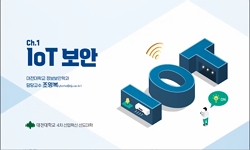IoT 기술의 급격한 발전으로 스마트홈이나 스마트 시티와 같은 다양한 편리한 서비스들이 실현되었다. 그러나 무인 환경에서의 IoT 기기는 도청 및 데이터 위조, 무단 액세스로 인한 정보 누...
http://chineseinput.net/에서 pinyin(병음)방식으로 중국어를 변환할 수 있습니다.
변환된 중국어를 복사하여 사용하시면 됩니다.
- 中文 을 입력하시려면 zhongwen을 입력하시고 space를누르시면됩니다.
- 北京 을 입력하시려면 beijing을 입력하시고 space를 누르시면 됩니다.

IoT 오픈 플랫폼 암호기술 현황 및 보안 요구사항 분석 = Analysis of IoT Open-Platform Cryptographic Technology and Security Requirements
한글로보기https://www.riss.kr/link?id=A105549630
-
저자
최정인 (부산대학교 SW교육센터) ; 오윤석 (한양대학교) ; 김도원 (한국인터넷진흥원) ; 최은영 (한국인터넷진흥원) ; 서승현 (한양대학교) ; Choi, Jung-In ; Oh, Yoon-Seok ; Kim, Do-won ; Choi, Eun Young ; Seo, Seung-Hyun

- 발행기관
- 학술지명
- 권호사항
-
발행연도
2018
-
작성언어
Korean
-
주제어
IoT 기기 등급 ; IoT 보안 요구사항 ; IoT 플랫폼 ; 암호기술
-
등재정보
KCI등재
-
자료형태
학술저널
-
수록면
183-194(12쪽)
-
KCI 피인용횟수
0
- DOI식별코드
- 제공처
- 소장기관
-
0
상세조회 -
0
다운로드
부가정보
국문 초록 (Abstract)
IoT 기술의 급격한 발전으로 스마트홈이나 스마트 시티와 같은 다양한 편리한 서비스들이 실현되었다. 그러나 무인 환경에서의 IoT 기기는 도청 및 데이터 위조, 무단 액세스로 인한 정보 누출 등 다양한 보안 위협에 노출되어 있다. 안전한 IoT 환경을 구축하려면 IoT 기기에 적절한 암호화 기술을 사용해야 한다. 그러나 IoT 기기의 제한된 자원으로 인해 기존 IT 환경에 적용된 암호화 기술을 그대로 적용하는 것은 불가능하다. 본 논문에서는 성능에 따라 IoT 디바이스의 분류를 조사하고 IoT 디바이스의 보안 요구 사항을 분석한다. 또한 AllJoyn, oneM2M, IoTivity와 같은 IoT 개방형 표준 플랫폼의 현재 암호화 기술의 사용 현황을 조사하고 분석한다. 암호화 기술 사용 현황에 대한 연구를 기반으로 각 플랫폼이 보안 요구사항을 만족하는지 확인한다. 각 IoT 개방형 플랫폼은 기밀성, 무결성, 인증 및 인증과 같은 보안 서비스를 지원하기위한 암호화 기술을 제공한다. 하지만 혈압 모니터링 센서와 같은 자원이 제한된 IoT 장치는 기존의 암호화 기법을 적용하기가 어렵다. 따라서 무인 환경에서 전력 제한 및 자원 제약을 받는 IoT 장치에 대한 암호화 기술을 연구 할 필요가 있다.
다국어 초록 (Multilingual Abstract)
With the rapid development of IoT(Internet of Things) technology, various convenient services such as smart home and smart city have been realized. However, IoT devices in unmanned environments are exposed to various security threats including eavesdr...
With the rapid development of IoT(Internet of Things) technology, various convenient services such as smart home and smart city have been realized. However, IoT devices in unmanned environments are exposed to various security threats including eavesdropping and data forgery, information leakage due to unauthorized access. To build a secure IoT environment, it is necessary to use proper cryptographic technologies to IoT devices. But, it is impossible to apply the technologies applied in the existing IT environment, due to the limited resources of the IoT devices. In this paper, we survey the classification of IoT devices according to the performance and analyze the security requirements for IoT devices. Also we survey and analyze the use of cryptographic technologies in the current status of IoT open standard platform such as AllJoyn, oneM2M, IoTivity. Based on the research of cryptographic usage, we examine whether each platform satisfies security requirements. Each IoT open platform provides cryptographic technology for supporting security services such as confidentiality, integrity, authentication an authorization. However, resource constrained IoT devices such as blood pressure monitoring sensors are difficult to apply existing cryptographic techniques. Thus, it is necessary to study cryptographic technologies for power-limited and resource constrained IoT devices in unattended environments.
참고문헌 (Reference)
1 "oneM2M"
2 M. B. Alaya, "Toward semantic interoperability in oneM2M architecture" 53 (53): 35-41, 2015
3 J. Swetina, "Toward a standardized common M2M service layer platform: Introduction to oneM2M" 21 (21): 20-26, 2014
4 "Threadgroup"
5 oneM2M Service Layer Core Protocol Specification, "TTAT.MM-TS.0004 v. 2.7.1 oneM2M - Service Layer Core Protocol Specification"
6 oneM2M Security, "TTAT.MM-TS.0003 v. 2.4.1 oneM2M - Security Solutions"
7 oneM2M Function Architecture, "TTAT.MM-TS.0001 v2.10.0 oneM2M - Functional Architecture"
8 oneM2M Authorization Architecture and Access Control Policy, "TTAT.MM-TR.0016 v. 2.0.0 oneM2M-Authorization Architecture and Access Control Policy"
9 oneM2M Security, "TTAT.MM-TR.0008 v. 2.0.0 oneM2M -Security"
10 Telecommunications Technology Association Standardization Committe, "TTAK.KO-12.0298 IoT device class classification and security requirement"
1 "oneM2M"
2 M. B. Alaya, "Toward semantic interoperability in oneM2M architecture" 53 (53): 35-41, 2015
3 J. Swetina, "Toward a standardized common M2M service layer platform: Introduction to oneM2M" 21 (21): 20-26, 2014
4 "Threadgroup"
5 oneM2M Service Layer Core Protocol Specification, "TTAT.MM-TS.0004 v. 2.7.1 oneM2M - Service Layer Core Protocol Specification"
6 oneM2M Security, "TTAT.MM-TS.0003 v. 2.4.1 oneM2M - Security Solutions"
7 oneM2M Function Architecture, "TTAT.MM-TS.0001 v2.10.0 oneM2M - Functional Architecture"
8 oneM2M Authorization Architecture and Access Control Policy, "TTAT.MM-TR.0016 v. 2.0.0 oneM2M-Authorization Architecture and Access Control Policy"
9 oneM2M Security, "TTAT.MM-TR.0008 v. 2.0.0 oneM2M -Security"
10 Telecommunications Technology Association Standardization Committe, "TTAK.KO-12.0298 IoT device class classification and security requirement"
11 "SmartThings Developer Documentation"
12 Jeong-Yong Eom, "Security technology for Home IoT / connected appliances" 34 (34): 10-16, 2017
13 O. Tomanek, "Security and privacy of using AllJoyn IoT framework at home and beyond" IEEE 2016
14 Gartner, "Predicts 2016: Security for the Internet of Things"
15 "Open Conectivity Foundation"
16 OCF Security, "OCF Security Specification, v.1"
17 "Machina research report"
18 Allseen Alliance, "Linux Foundation"
19 Dave Smith, "Just Android Things"
20 "Iotivity Security"
21 A. Subash, "IoTivity-Connecting Things in IoT" 2015
22 K. Ashwini, "IoTivity Provisioning Manager Design Specification v0.1d"
23 Internet of Things Forum, "IoT device class classification and security requirement"
24 "IoT Small Smart Home Appliance Security Guide"
25 "IoT Security Survey Results (SANS Institute data)"
26 The Korea Internet & Security Agency (KISA), "Guide to Using Cryptography Authentication Technology in Internet of Things(IoT) Environment"
27 "Android Things SDK overview"
28 M. Villari, "Alljoyn lambda: An architecture for the management of smart environments in iot" IEEE 9-14, 2014
29 A. Alliance, "Alljoyn framework. Linux Foundation Collaborative Projects"
30 "AllSeen Alliance Security"
31 "AllJoyn Security 2.0 Feature: High-level Design"
동일학술지(권/호) 다른 논문
-
뉴로-퍼지를 이용한 수면 외적 요인과 개인 수면 각성의 관계 영향 요소 분석
- 한국정보처리학회
- 하정호
- 2018
- KCI등재
-
R&D 프로세스 성숙도가 제품개발 성과에 미치는 영향: R&D 프로젝트 성과의 매개효과를 중심으로
- 한국정보처리학회
- 신경식
- 2018
- KCI등재
분석정보
인용정보 인용지수 설명보기
학술지 이력
| 연월일 | 이력구분 | 이력상세 | 등재구분 |
|---|---|---|---|
| 2027 | 평가예정 | 재인증평가 신청대상 (재인증) | |
| 2021-01-01 | 평가 | 등재학술지 유지 (재인증) |  |
| 2018-01-01 | 평가 | 등재학술지 유지 (등재유지) |  |
| 2015-01-01 | 평가 | 등재학술지 유지 (등재유지) |  |
| 2012-10-31 | 학술지명변경 | 한글명 : 컴퓨터 및 통신시스템 -> 정보처리학회논문지. 컴퓨터 및 통신시스템 |  |
| 2012-10-10 | 학술지명변경 | 한글명 : 정보처리학회논문지A -> 컴퓨터 및 통신시스템외국어명 : The KIPS Transactions Part : A -> KIPS Transactions on Computer and Communication Systems |  |
| 2010-01-01 | 평가 | 등재학술지 유지 (등재유지) |  |
| 2009-03-04 | 학술지명변경 | 한글명 : 정보처리학회논문지 A, B, C, D -> 정보처리학회논문지 A외국어명 : The KIPS Transactions Part : A, B, C, D -> The KIPS Transactions Part : A |  |
| 2009-03-04 | 학술지명변경 | 한글명 : 정보처리학회논문지 A -> 정보처리학회논문지A |  |
| 2008-01-01 | 평가 | 등재학술지 유지 (등재유지) |  |
| 2006-01-01 | 평가 | 등재학술지 유지 (등재유지) |  |
| 2003-01-01 | 평가 | 등재학술지 선정 (등재후보2차) |  |
| 2002-01-01 | 평가 | 등재후보 1차 PASS (등재후보1차) |  |
| 2000-07-01 | 평가 | 등재후보학술지 선정 (신규평가) |  |
학술지 인용정보
| 기준연도 | WOS-KCI 통합IF(2년) | KCIF(2년) | KCIF(3년) |
|---|---|---|---|
| 2016 | 0.16 | 0.16 | 0.14 |
| KCIF(4년) | KCIF(5년) | 중심성지수(3년) | 즉시성지수 |
| 0.12 | 0.11 | 0.315 | 0.07 |




 ScienceON
ScienceON KISS
KISS





